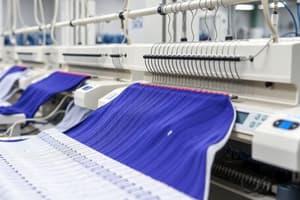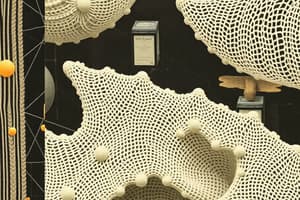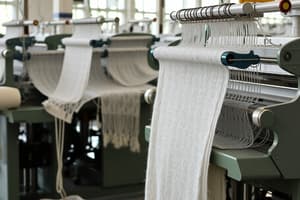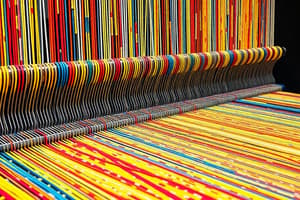Podcast
Questions and Answers
What is the purpose of a knitting machine?
What is the purpose of a knitting machine?
- To produce knitted fabrics in a semi or fully automated fashion (correct)
- To produce sewn fabrics
- To produce woven fabrics
- To produce crocheted fabrics
What are the different types of knitting machines?
What are the different types of knitting machines?
- Simple spool or board templates with no moving parts, and highly complex mechanisms controlled by pneumatics
- Simple spool or board templates with no moving parts, and highly complex mechanisms controlled by hydraulics
- Simple spool or board templates with no moving parts, and highly complex mechanisms controlled by electronics (correct)
- Simple spool or board templates with no moving parts, and highly complex mechanisms controlled by mechanics
Which type of fabrics can be produced using a knitting machine?
Which type of fabrics can be produced using a knitting machine?
- Various types of crocheted fabrics, usually either flat or tubular, and of varying degrees of complexity
- Various types of sewn fabrics, usually either flat or tubular, and of varying degrees of complexity
- Various types of knitted fabrics, usually either flat or tubular, and of varying degrees of complexity (correct)
- Various types of woven fabrics, usually either flat or tubular, and of varying degrees of complexity
How can pattern stitches be selected on a knitting machine?
How can pattern stitches be selected on a knitting machine?
What type of knitting method is used in domestic knitting machines?
What type of knitting method is used in domestic knitting machines?
What is the difference between fabric produced using a knitting machine and hand-knitted fabric?
What is the difference between fabric produced using a knitting machine and hand-knitted fabric?
What type of machines are needed to produce larger and more complex knitted items, such as garments?
What type of machines are needed to produce larger and more complex knitted items, such as garments?
What is required to create more complex stitch transfers, such as cable stitches?
What is required to create more complex stitch transfers, such as cable stitches?
What is the range of yarn weight that can be knit on a standard gauge 200-needle machine?
What is the range of yarn weight that can be knit on a standard gauge 200-needle machine?
Flashcards
Knitting Machines
Knitting Machines
Machines used to produce knitted fabrics automatically or semi-automatically.
Types of Knitted Fabrics
Types of Knitted Fabrics
Flat or tubular fabrics with varying complexities produced by knitting machines.
Weft Knitting
Weft Knitting
A knitting method used by domestic knitting machines that produces a fabric similar to hand knitting.
Bearded Needles
Bearded Needles
Signup and view all the flashcards
Industrial Knitting Machines
Industrial Knitting Machines
Signup and view all the flashcards
Automatic Patterning
Automatic Patterning
Signup and view all the flashcards
Domestic and Industrial Machines
Domestic and Industrial Machines
Signup and view all the flashcards
Machine-Knitted Texture
Machine-Knitted Texture
Signup and view all the flashcards
Standard Gauge Machine
Standard Gauge Machine
Signup and view all the flashcards
Study Notes
Knitting Machine: A Summary
- Knitting machines are used to produce knitted fabrics in a semi or fully automated fashion.
- There are different types of knitting machines, ranging from simple spool or board templates with no moving parts to highly complex mechanisms controlled by electronics.
- Knitting machines produce various types of knitted fabrics, usually either flat or tubular, and of varying degrees of complexity.
- Pattern stitches can be selected by hand manipulation of the needles, push-buttons and dials, mechanical punch cards, or electronic pattern reading devices and computers.
- Early flat bed stocking frames had low carbon steel bearded needles where the tips were reflexed and could be depressed onto a hollow closing the loop.
- To produce larger and more complex knitted items, such as garments, domestic and industrial machines, with either flat or circular beds, producing rectangular or tubular fabrics, respectively, are needed.
- Automatic patterning machines can knit two-colour Fair Isle patterns automatically and have machine stitch patterning features such as slipping, tucking, plating, and knitweaving.
- Domestic knitting machines use the weft knitting method which produces a fabric similar to hand knitting.
- The fabric produced using a knitting machine is of a more even texture than flat knitting, hand-knitted fabric, which is particularly noticeable on large areas of plain stockinette stitch.
- More complex stitch transfers, such as cable stitches, require hand-manipulation to cross the groups of stitches over each other.
- Industrial machines that offer selective, automatic stitch transfer between front and back beds along with racking of the beds can create cable stitch automatically.
- The standard gauge 200-needle machine can knit the finest yarns up to a good sport-weight (4ply UK), while the heavier yarns knit better on a mid-gauge or bulky knitting machine.
- Machine knitting saves a considerable amount of time but does require learning to operate the machines correctly.
Studying That Suits You
Use AI to generate personalized quizzes and flashcards to suit your learning preferences.




